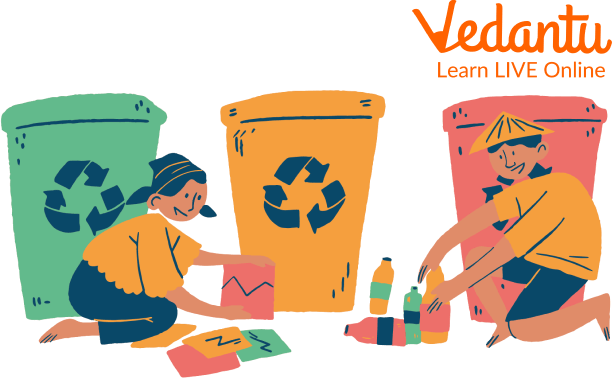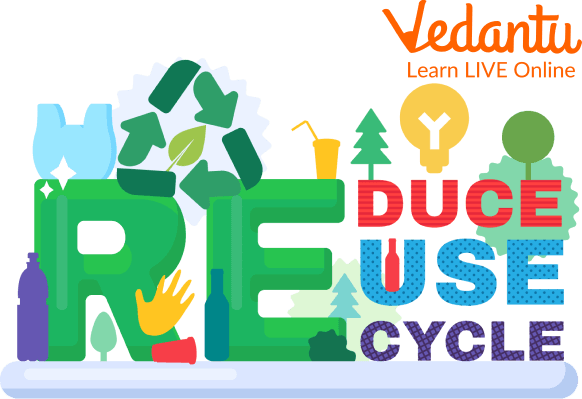




Introduction To Recycling For Kids
Kids, I am sure you all throw garbage in the dustbin. We learn this manner at our home and in school too. But what if we do not throw useful garbage? Do not get shocked. Yes, we can do so. This process is known as recycling. So, let us learn about recycling in detail. Recycling is a method for taking garbage and transforming it into new items. The absolute most normal cycles being used today include reusing plastic, glass, metals, paper, electronics, and materials. These all are the recycling of waste materials for kids. Regularly utilised things made of these materials incorporate soft drink jars, plastic milk containers, papers, old PCs, and cardboard boxes. Here we will learn how recycling is helpful in our everyday life.

Recycling
How Does Recycling Work?
Make sure to reuse all that you can in your home and school. There is quite often a "recycle" garbage bin around. Also, you can drop your pre-used aluminium jars and plastic containers there. At home, make sure to put paper-based things like used papers, cereal boxes, and schoolwork pages into the recycle bin. This will be a recycling activity for kids. This will be a recycling activity for kids and also waste management for kids.
Aluminium Jars - Aluminium jars were possibly the earliest to be intensely reused. The cycle isn't exactly as convoluted as it seems to be for a few different materials. The jars are first destroyed and afterwards softened. From that point, the aluminium can be used to make new jars and other things.
Plastic Jugs - There are a ton of kinds of plastics and each type is produced using an alternate mix of synthetic compounds.
Accordingly, plastic containers are first arranged into different substance types. Then, at that point, they are cleaned to dispose of any extra food or other waste. Then, the containers are squashed or destroyed into fine plastic chips.
Then the chips can be broken down to make new plastic or transformed into a fibre utilised for making floor coverings or dresses.
Paper - Paper begins its recycling by being blended in with water and different synthetic compounds to separate it. It then, at that point, gets destroyed and warmed up.
This process finally transforms the paper into a mash or slurry. The mash sets are stressed up to eliminate any pastes or plastics. From that point onward, it gets cleaned and faded to eliminate any leftover inks or colours. Presently the mash is fit to be made into new paper.
PCs and Batteries - Computers and batteries are typically reused to eliminate unsafe synthetic compounds and recuperate or recover a few significant materials, for example, gold from hardware sheets. This is a recycling of waste materials for kids and waste management for kids.
The Recycling Loop
The recycling loop has three bolts. Every arrow addresses an alternate move toward the recycling system. This means Gathering recyclable materials, similar to aluminium jars and plastic jugs. Handling the old materials and making new things. Purchasing things produced using recycled materials.

Recycling Loop
Summary
Plastics are normally set apart with an ID code that shows a recycling image and a number from 1 to 7. This shows the chemicals, or polymer used to make the plastic. Utilised paper can be recycled multiple times. After this, the fibres get excessively short and are sifted through by the reusing system. Some waste material is transformed into power energy by consuming it in current incinerators. Glass is one of the most incredible recycling materials. Clear glass can be reused again and again. In 2009, the United States reused around 1/3 of its waste. Around 7 million tons of metals were reused.
FAQs on Recycling For Kids
1. What does recycling mean in a simple way for kids?
Recycling is the process of taking old or used items that we would normally throw away, like plastic bottles, paper, and glass jars, and turning them into brand-new products. Instead of letting them become waste in landfills, we give them a new life. For example, old newspapers can be recycled to make new books or cardboard boxes.
2. Why is it so important for us to recycle our waste?
Recycling is very important for keeping our planet healthy. It helps in many ways:
Conserves Natural Resources: It saves valuable materials like trees, water, and minerals because we reuse what we already have.
Reduces Pollution: Making products from recycled materials usually creates less air and water pollution than making them from new raw materials.
Saves Energy: It often takes much less energy to make new things from recycled items than from scratch.
Protects Wildlife: By reducing the need to cut down forests or mine for metals, we help protect the homes of animals.
3. What are the three golden rules of waste management, known as the 3 R's?
The three golden rules, or the 3 R's, are Reduce, Reuse, and Recycle. They provide a simple guide for protecting our environment:
Reduce: This means making less waste in the first place. For example, avoiding single-use plastic bags and using a cloth bag instead.
Reuse: This means using items again before throwing them away. For example, using a glass jar to store pencils or turning an old t-shirt into a cleaning rag.
Recycle: This is the last step, where we turn old items that cannot be reused into new products.
4. How are 'Reduce' and 'Reuse' different from 'Recycling'?
'Reduce' and 'Reuse' are different from 'Recycling' because they are ways to prevent waste from being created in the first place. 'Reduce' is about using fewer things, while 'Reuse' is about finding new ways to use an item as it is. 'Recycling' is what you do when an item has finished its life and needs to be broken down and turned into something completely new. The best order to follow is always Reduce first, then Reuse, and finally, Recycle.
5. What are some common examples of items that can be recycled from our homes?
Many everyday items in our homes can be recycled. Some common examples include:
Paper and Cardboard: Newspapers, magazines, old notebooks, cereal boxes, and cardboard packaging.
Plastics: Drink bottles, milk jugs, and shampoo bottles (check for the recycling symbol).
Glass: Food jars (like jam or pickles) and glass bottles.
Metals: Aluminium cans (like soft drinks) and steel food cans.
6. What are some easy ways for kids to start recycling at home?
Kids can easily become recycling champions at home! A great way to start is by setting up separate bins for different types of waste. You can have one bin for paper, another for plastic and glass, and one for general waste. You can also help your family by rinsing out jars and bottles before putting them in the recycling bin and squashing plastic bottles to save space.
7. Can all types of plastic be recycled?
This is a common point of confusion. The answer is no, not all plastics can be easily recycled. Plastics have different numbers inside a triangle symbol (from 1 to 7) that tell us what kind they are. Plastics with numbers 1 (like water bottles) and 2 (like milk jugs) are widely recycled. However, others like plastic bags, straws, and wrappers are often difficult to recycle and should not be mixed with your regular recycling unless your local program specifically asks for them.
8. What happens to a plastic bottle after we put it in the recycling bin?
After you put a plastic bottle in the recycling bin, it goes on a long journey. First, it's collected and taken to a special factory called a Materials Recovery Facility (MRF). There, it is sorted from other materials like paper and glass. The bottles are then cleaned, shredded into tiny flakes, melted down, and formed into small pellets. These pellets become the raw material to make new items like more bottles, clothing, carpets, or even playground equipment.









